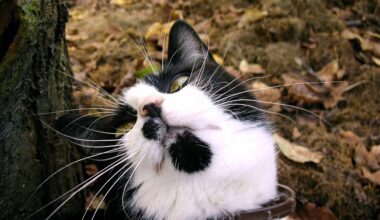Dietary Strategies for Cats with Diabetes
Managing diabetes in cats can be challenging, but a carefully structured diet plays an essential role in stabilizing their blood sugar levels. Owners should consult with their veterinarian to develop a nutrition plan tailored to their cat’s individual needs. It is crucial to choose the right type of food, focusing on low carbohydrate options to help control glucose levels. Additionally, providing consistent meal times can aid in managing insulin needs effectively. While some may consider feeding dry kibble, many veterinarians recommend wet food due to its beneficial moisture content. The increased hydration helps support kidney function, which can be particularly important for diabetic cats. Moreover, owners should look for high protein content in the food to promote muscle maintenance. This dietary aspect can also help to manage weight, reducing the risk of obesity, which is often a concern in diabetic cats. Avoid giving treats that are high in sugars or carbohydrates and opt for healthier alternatives, ensuring any snacks adhere to the overall diet plan. Regular monitoring and adjustments based on professional advice will support long-term success in managing diabetes through nutrition.
In addition to choosing the right food, considering specific dietary ingredients can significantly impact a diabetic cat’s health. Fiber plays an important role in managing diabetes since it helps regulate blood sugar levels. Foods high in soluble fiber can slow down glucose absorption and enhance overall digestive health. Research suggests that ingredients like psyllium or beet pulp may be beneficial in creating a balanced diet for diabetic pets. Furthermore, incorporating omega-3 fatty acids found in fish oil can help reduce inflammation and improve insulin sensitivity. Regularly including these components can contribute to better health outcomes for diabetic cats. Another consideration pertains to the importance of eating schedule. Feeding smaller, more frequent meals throughout the day can stabilize blood sugar levels and meet the cat’s energy needs without overwhelming their system. Monitoring portion sizes is crucial to avoid excessive calorie intake, which can lead to weight gain. Cats should never be allowed to graze; instead, owners should set strict meal times and measure portions accurately. Consultation with a vet can streamline this process to maximize health management effectiveness for cats diagnosed with diabetes.
Hydration and its Importance
Proper hydration is vital for all cats, especially those suffering from diabetes. Cats are naturally inclined to have low thirst drive, which can inadvertently lead to dehydration issues, especially when they consume dry food. Increasing water intake should be a priority for owners. One effective technique is to include wet food in their diet, which provides additional moisture. Pet owners can also introduce fresh, clean water bowls in various locations around their home. Cats may be attracted to running water, making pet water fountains an appealing option for increasing fluid consumption. Adding bone broth or low-sodium broth to their food can serve as an enticing method to boost hydration while also providing nutrients. Beyond just food, consider offering ice cubes or freeze-dried treats to encourage playful hydration methods. Keeping a lookout for signs of dehydration is also essential; these include lethargy, dry mouth, and loss of skin elasticity. Always consult with a veterinarian about hydration strategies that best suit your cat’s specific health needs. A well-hydrated diabetic cat is notably more likely to have controlled glucose levels, thus enhancing overall quality of life.
Many owners may wonder whether supplements can benefit their diabetic cats. While a well-balanced commercial diet generally provides essential nutrients, there are specialized supplements that may offer added support. For instance, a veterinarian may recommend certain vitamins or minerals that assist with insulin sensitivity or blood sugar regulation. Supplements such as chromium have shown potential benefits in glucose metabolism for diabetic cats. Always consult a veterinarian before introducing any new supplements to ensure they are safe and appropriate. Additionally, keep in mind that supplements should never replace quality nutrition; rather, they should complement it. Regular check-ups and blood tests allow for the adjustment of both diet and supplements as required based on how the cat responds. In some cases, diabetic cats may also require insulin therapy, and dietary management should align closely with any medical interventions. Each cat reacts differently, which makes personalized plans crucial for effective management. Documentation of food intake, energy levels, and glucose readings will aid in guiding conversations with the veterinarian about any necessary adjustments to both diet and supplements.
Experimenting with Foods
Every cat is unique, especially those diagnosed with diabetes. Owners might find it essential to experiment with various brands and formulations of cat food to identify the ones their pets prefer and that meet their health needs. Introducing new foods gradually can help avoid digestive upset. Start by mixing a small amount of the new food with the existing diet and gradually increasing the ratio over a week or so. This method allows the cat to acclimate to the new taste and texture while ensuring their digestive system remains stable. It’s vital to read ingredient labels carefully; look for high-quality protein sources and avoid fillers, artificial additives, or high-carb ingredients like corn. Additionally, always be on the lookout for any adverse reactions to the new foods, such as gastrointestinal distress or changes in energy levels. It might take several attempts to find the ideal diet, but persistence is key. Consulting online reviews and forums can provide insights into how other pet owners have successfully navigated feeding challenges with their diabetic cats, contributing valuable information to personal experiments.
Weight management is a critical aspect of caring for diabetic cats and can be significantly influenced by dietary choices. Obesity is a common concern and can complicate diabetes management. Therefore, understanding caloric requirements is essential. Generally, a weight-loss plan for a cat should facilitate a slow and steady reduction in weight without denying necessary nutrients. During the transition, reducing calorie intake without compromising quality is important for overall health. Cat parents should also prioritize high-protein diets, as they can help maintain lean muscle mass while promoting weight loss. Monitoring body condition scores regularly can help track progress effectively. Cats often require a different caloric intake based on their activity level, age, and overall health condition. Thus, it is advisable to consult a veterinarian to develop a weight management plan tailored to individual needs. In addition to food adjustments, incorporating play and exercise into daily routines can further support healthy weight maintenance. Interactive toys and scheduled play sessions can encourage physical activity and make it enjoyable for the cat, thus encouraging a healthier lifestyle overall.
Takeaway for Owners
Ultimately, managing diabetes in cats requires dedication from their owners, especially concerning dietary choices. Understanding the importance of a tailored diet, hydration, and weight management is critical for achieving optimal health outcomes for diabetic cats. With the myriad of available food products, ingredient lists must be scrutinized, ensuring they meet specific carbohydrate and protein content guidelines. Each cat’s needs can evolve, making regular veterinary check-ups essential for fine-tuning diet plans. Owners must also be proactive in monitoring behavioral changes, energy levels, and overall health as these can indicate necessary adjustments. Implementing a consistent eating schedule, coupled with engaging hydration strategies and proper nutrition, can help stabilize glucose levels. Education on the impacts of obesity and the roles of supplements serve to support a holistic approach to cat health. As pet owners navigate the challenges of managing diabetes, resources and professional advice will provide foundational support throughout. Through love, commitment, and informed decision-making, owners can contribute to their cats’ long-term well-being and happiness.
Finally, community support can be invaluable in addressing the complexities of feeding cats with diabetes. Engaging with other pet owners through online forums, social media groups, or local meet-ups can offer shared experiences and practical advice on nutrition and daily management strategies. Learning from others who face similar challenges can lighten the emotional load and offer valuable insight into effective techniques for managing special dietary needs. Networking with veterinarians and pet nutritionists can also enhance understanding, providing clarity on new dietary trends and research in feline diabetes. Additionally, owners may benefit from educational resources available online, including articles, webinars, and videos focusing on cat nutrition. Local pet supply stores or specialty shops often provide opportunities for workshops or informative sessions on diabetic cat care, including proper diet. Participating in such educational opportunities can empower owners with skills and knowledge applicable to their own cats. Connecting with a supportive community fosters a sense of solidarity while navigating the journey of managing feline diabetes. Adequate insights help enable owners to cultivate the best possible life for their beloved companions ultimately.


